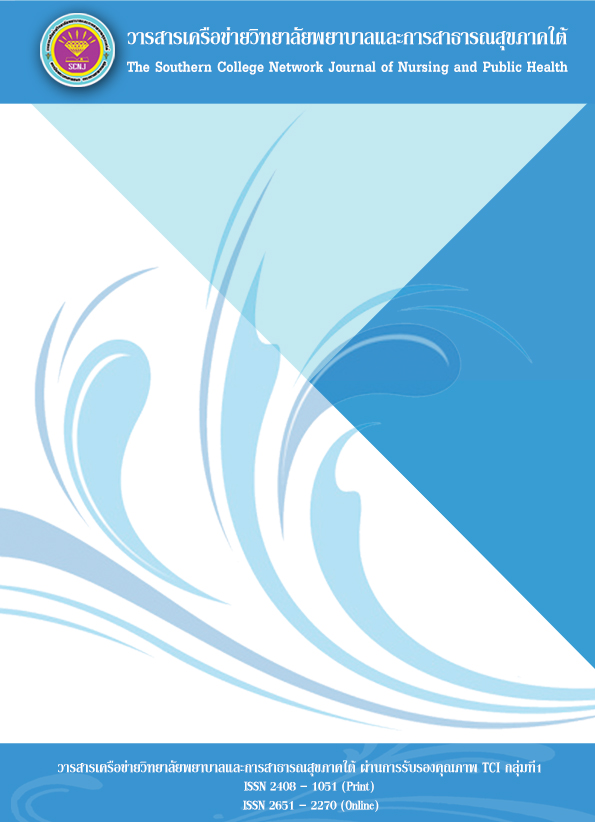การประยุกต์ใช้ระบบสารสนเทศภูมิศาสตร์ในงานสาธารณสุข
คำสำคัญ:
ระบบสารสนเทศภูมิศาสตร์, สาธารณสุข, การประยุกต์ใช้บทคัดย่อ
ระบบสารสนเทศภูมิศาสตร์ เป็นกระบวนการทำงานโดยใช้ระบบคอมพิวเตอร์ ซึ่งเกี่ยวกับข้อมูลเชิงพื้นที่ โดยใช้ข้อมูลเชิงบรรยาย ที่มีความสัมพันธ์กับตำแหน่งในเชิงพื้นที่ ในรูปของตารางข้อมูล และฐานข้อมูล ปัจจุบันมีการใช้ระบบสารสนเทศภูมิศาสตร์มาอธิบายความสัมพันธ์เชิงพื้นที่ในศาสตร์หลาย ๆ แขนง ทำให้ผู้ใช้งานสามารถเห็นข้อมูลตามสภาพความเป็นจริงในทางสาธารณสุขก็ได้นำระบบสารสนเทศภูมิศาสตร์มาใช้อย่างแพร่หลาย ในบทความนี้ผู้เขียน นำเสนอประเด็นที่มีความเกี่ยวข้องกับการใช้ระบบสารสนเทศภูมิศาสตร์ในงานสาธารณสุข ได้แก่ การประยุกต์ใช้ระบบสารสนเทศภูมิศาสตร์ในการควบคุมโรคติดต่อ การจัดการโรคไม่ติดต่อและการส่งเสริมสุขภาพ การวางแผนสาธารณสุขสำหรับอนามัยสิ่งแวดล้อม อาชีวอนามัยและความปลอดภัย ซึ่งจะเห็นได้ว่าระบบสารสนเทศภูมิศาสตร์สามารถนำมาใช้เป็นเครื่องมือในการดำเนินงานทางด้านสาธารณสุขได้
เอกสารอ้างอิง
Barcus, H. R., & Halfacree, K. (2018). An Introduction to Population Geographies: Lives Across Space. Abingdon, Oxon: Routledge.
Cuadros, D. F., Li, J., Branscum, A. J., Akullian, A., Jia, P., Mziray, E. N., et al. (2017). Mapping the Spatial Variability of HIV Infection in Sub-Saharan Africa: Effective Information for Localized HIV Prevention and Control. Scientific Reports, 7(1).
Fujita, M., Sato, Y., Nagashima, K., Takahashi, S., & Hata, A. (2017) Impact of Geographic Accessibility on Utilization of the Annual Health Check-Ups by Income Level in Japan: A Multilevel Analysis, PLoS One, 12(5).
Jaraeprapal, U., & Aekwarangkoon S. (2008). Geographic Information System Development for Community Health Promotio. Thai Journal of Nursing Council, 23(3), 50-60. (in Thai)
Jirakajohnkool, S., Junkaew, N., Oumkratum, S., & Klawwikarn, P. (2011). Geo-Informatics for Increasing Healthy Cities Project Efficiency and Service Zone, Nakhon Si Thammarat Province. Thai Science and Technology Journal, 2(19), 64-74. (in Thai)
Kongmung, K. (2010). Application of Geographic Information System of Epidemiological Surveillance. Built Environment Inquiry Journal Faculty of Architecture Khon Kaen University, Thailand, 9(1), 76-89. (in Thai)
Korphayakkhin, T., Tipayamonkholgul, M., & Areechokchai, D. (2018). Spatial Autocorrelation of Dengue Fever at Village Level in Tak Province, 2014-2016. Paper Presented at the 16th National Conference on Public Health, Mahidol. Retrieved September 1, 2019 from https://www.ph.mahidol.ac.th/phep/Present_Teerawadee2018.pdf
Li, M., Li, R., Shen, Z., Li, C., Liang, N., Peng, Z., ed al, (2017). Spatial Distribution of HIV, HCV, and Co-Infections among Drug Users in the Southwestern Border Areas of China (2004-2014): a Cohort Study of a National Methadone Maintenance Treatment Program. BMC Public Health, 17(1).
Li, Y., Wang, J., Gao, M., Fang, L., Liu, C., Lyu, X., et al (2017). Geographical Environment Factors and Risk Assessment of Tick-Borne Encephalitis in Hulunbuir, Northeastern China. International Journal of Environmental Research and Public Health, 14(6).
Lyseen, A. K., Nøhr, C., Sørensen, E. M., Gudes, O., Geraghty, E. M., Shaw, N. T., et al, (2014). A Review and Framework for Categorizing Current Research and Development in Health Related Geographical Information Systems (GIS) Studies. Yearbook of Medical Informatics, 9(1), 110-124.
Malek Mohammadi, T., Derakhshani, R., Tavallaie, M., Raoof, M., Hasheminejad, N., & Haghdoost, A. A. (2017). Analysis of Ground Water Fluoride Content and its Association with Prevalence of Fluorosis in Zarand/Kerman: (Using GIS). Journal of Dental Biomaterials, 4(2), 379–386.
Musa, G. J., Chiang, P. H., Sylk, T., Bavley, R., Keating, W., Lakew, B., et al (2013). Use of GIS Mapping as a Public Health Tool-From Cholera to Cancer. Health Services Insights, 6, 111-116.
Nyandwi, E., Veldkamp, A., Amer, S., Karema, C., & Umulisa, I. (2017) Schistosomiasis Mansoni Incidence Data in Rwanda can Improve Prevalence Assessments, by Providing High-Resolution Hotspot and Risk Factors Identification. BMC Public Health, 17(1).
Peterson, J. (2017). The Role of Health Information Management Professionals in the Use of Geographic Information Systems. Perspectives in Health Information Management, 14(Summer), 1b.
Prasartkul, P., & Vapattanawong, P. (2011). Transitional Point of the Thai Population. Thailand's Population in Transition : a Turning Point for Thai Society. Nakhon Pathom: Institute for Population and Social Research, Mahidol University.
Reunthongdee, U. (2015). The Effectiveness of the “Disease Map” in the Community Health Promotion, Burapha Journal of Medicine, 2(2), 11-21. (in Thai)
Sermkarndee, P., Manwicha, J., & Khunchoo, R., (2016). Risk Areas Analysis of Dengue Fever Using Geographic Information Systems, Hatyai District, Songkhla Province. Paper presented at the The 10th Hatyai National and International Conference, Hatyai University.
Shiode, N., Shiode, S., Rod-Thatcher, E., Rana, S., & Vinten-Johansen, P. (2015). The Mortality Rates and the Space-Time Patterns of John Snow's Cholera Epidemic Map. International Journal of Health Geographics, 14, 21.
Stopka, T. J., Goulart, M. A., Meyers, D. J., Hutcheson, M., Barton, K., Onofrey, S., et al, (2017). Identifying and Characterizing Hepatitis C Virus Hotspots in Massachusetts: a Spatial Epidemiological Approach. BMC Infectious Diseases, 17(1), 294.
Thanyarat, C., & Jirakajohnkool S. (2014). Geographic Information Systems Application for Volatile Organic Compounds (VOCs) Risk Zone Analysis, in Rayong Province. Thai Journal of Science and Technology, 3(3), 160-172 (in Thai)
Tipayamongkholgul, M. (2012). Spatial Epidemiology in Public Health. Journal of Public Health, 42(3), 44-54. (in Thai)
Usadee, C. (2016). Applied Geographic Information Systems (GIS) for Management Human Vulnerability to Chemical Disaster in an Industrial Estate of Banchang District (Independent study master of public health). Thammasat University, Pathum Thani. (in Thai)
Wang, W., Winner, M., & Burgert-Brucker, C. R. (2017). Limited Service Availability, Readiness, and Use of Facility-Based Delivery Care in Haiti: A Study Linking Health Facility Data and Population Data. Global Health, Science and Practice, 5(2), 244–260.
WHO. (2010). Monitoring The Building Blocks of Health System: a Handbook of Indicators and Their Measurement Strategies. Switzerland: WHO Document Production Services.
ดาวน์โหลด
เผยแพร่แล้ว
ฉบับ
ประเภทบทความ
สัญญาอนุญาต
1. บทความหรือข้อคิดเห็นใด ๆ ที่ปรากฏในวารสารเครือข่าย วิทยาลัยพยาบาลและการสาธารณสุขภาคใต้ ที่เป็นวรรณกรรมของผู้เขียน บรรณาธิการหรือเครือข่ายวิทยาลัยพยาบาลและวิทยาลัยการสาธารณสุขภาคใต้ ไม่จำเป็นต้องเห็นด้วย
2. บทความที่ได้รับการตีพิมพ์ถือเป็นลิขสิทธิ์ของ วารสารเครือข่ายวิทยาลัยพยาบาลและการสาธารณสุขภาคใต้








